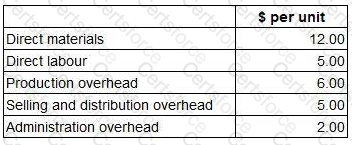Which of the following is a relevant cost?
A company operates an integrated standard cost accounting system. The standard price of raw material A is $20 per litre. At the start of period 1, the inventory of 500 litres of raw material A was valued at $20 per litre. During period 1, 100 litres of raw material A were purchased at an actual price of $21 per litre. During period 2, 550 litres of raw material A were issued to Job 789.
In respect of the above events, which TWO of the following statements are correct? (Choose two.)
A company uses full cost pricing. The unit costs for product Z are given below.

What price per unit should be charged in order to achieve a profit margin of 20%?
Give your answer to the nearest cent.
Which of the following would NOT require taking into account the time value of money?
A company makes and sells a range of products. The standard details per unit for one of these products, product X, are as follows.

To meet sales demand, the company must obtain 2,000 units of product X next month. There is sufficient labour capacity to produce 1,500 of these units in-house during normal time. However, any production above this level would require overtime working which would be paid at a premium of 50%.
The company can buy as many units of product X as it wishes next month from an external supplier at a price of $120 per unit.
What is the total financial benefit to the company of purchasing the appropriate number of units from the external supplier rather than producing them in-house?
The year-to-date results at the end of month 9 included sales revenue of $3,600,000 and variable costs of $2,100,000.
During month 10, sales revenue was $450,000 and variable costs were $270,000.
What year-to-date contribution to sales ratio (C/S ratio) would be reported at the end of month 10?
An organisation’s management report contains the following data:

Which division has the highest operating margin percentage?
Which of the following is a valid definition of a cash budget?
According to CIMA’s Code of Ethics, CIMA members should not allow bias, conflict of interest of the influence of other people to override their professional judgement.
This is an example of:
The following data are available for a company that produces and sells a single product.
The company’s opening finished goods inventory was 2,500 units.
The fixed overhead absorption rate is $8.00 per unit.
The profit calculated using marginal costing is $16,000.
The profit calculated using absorption costing and valuing its inventory at standard cost is $22,400.
The company’s closing finished goods inventory is: